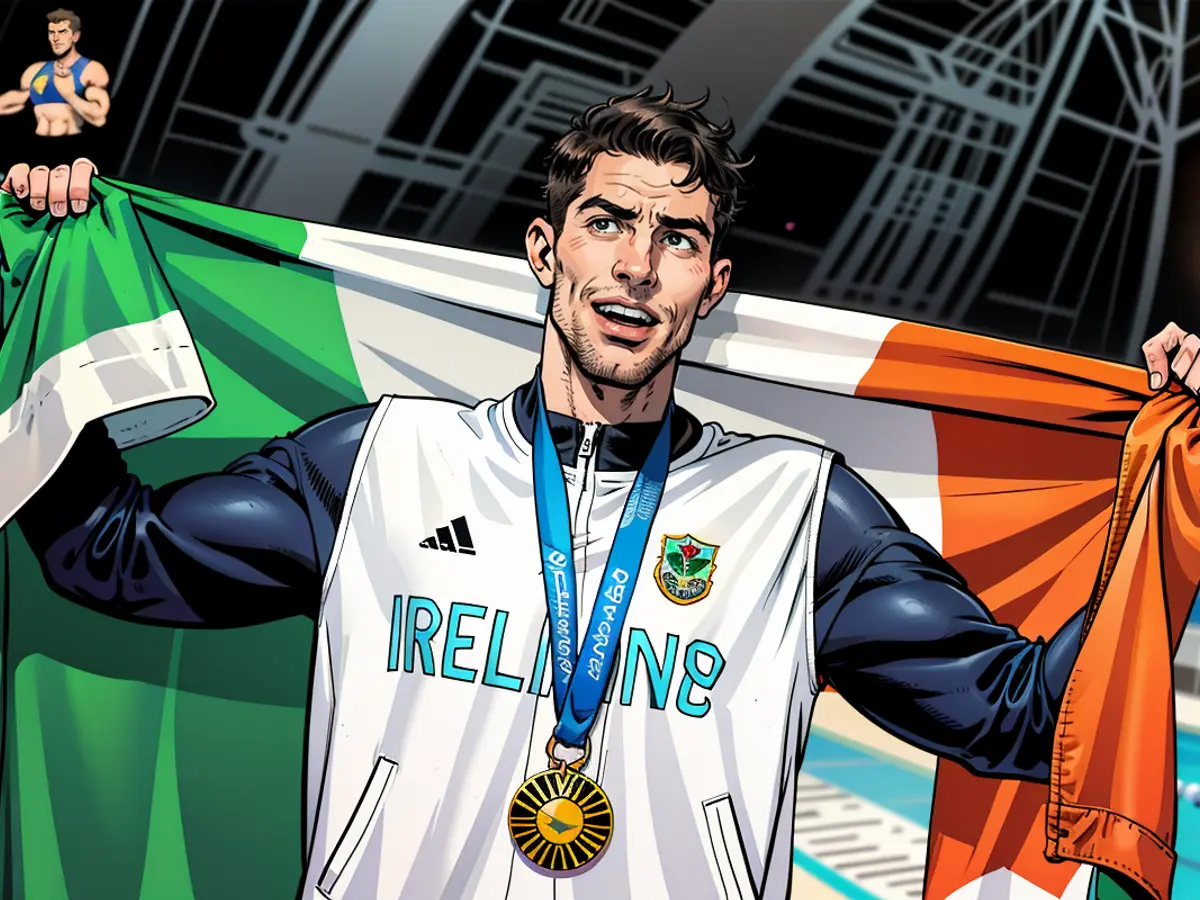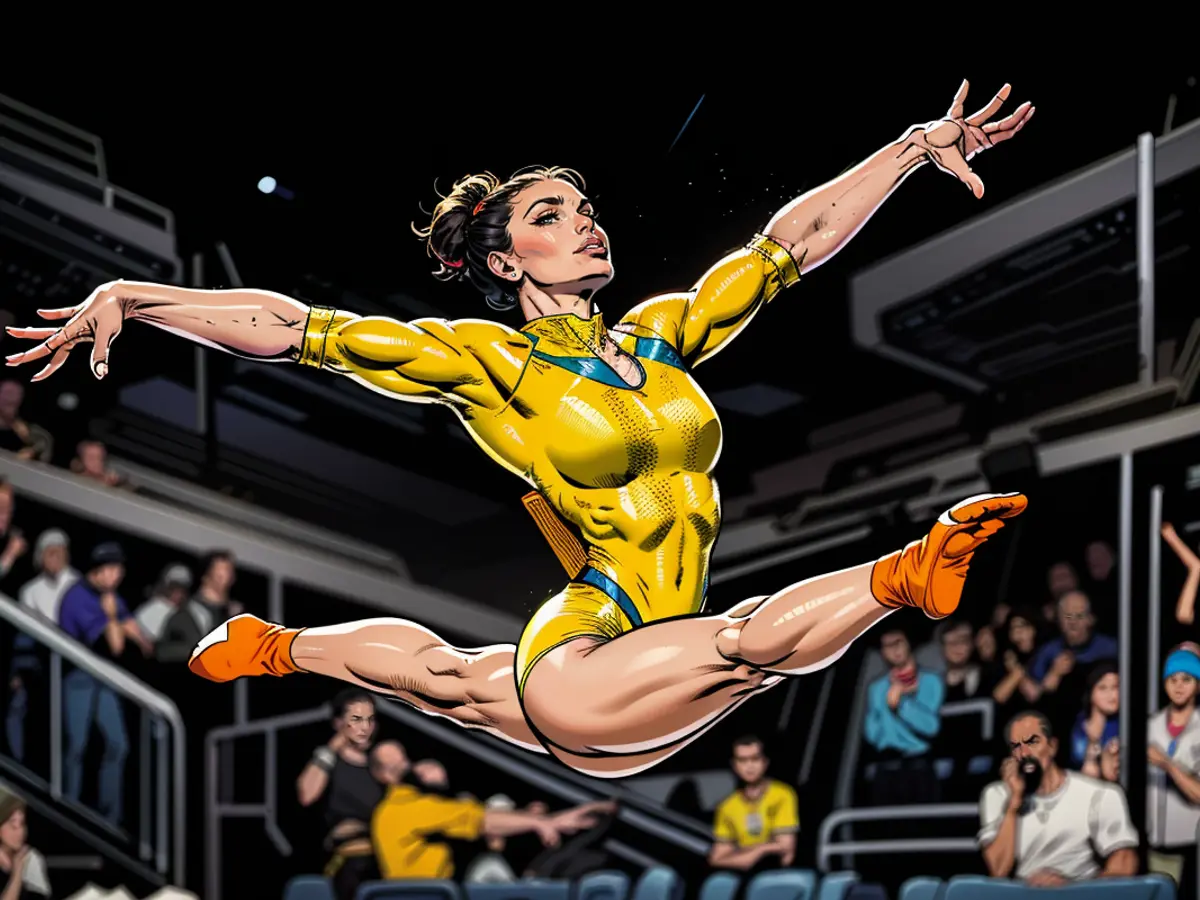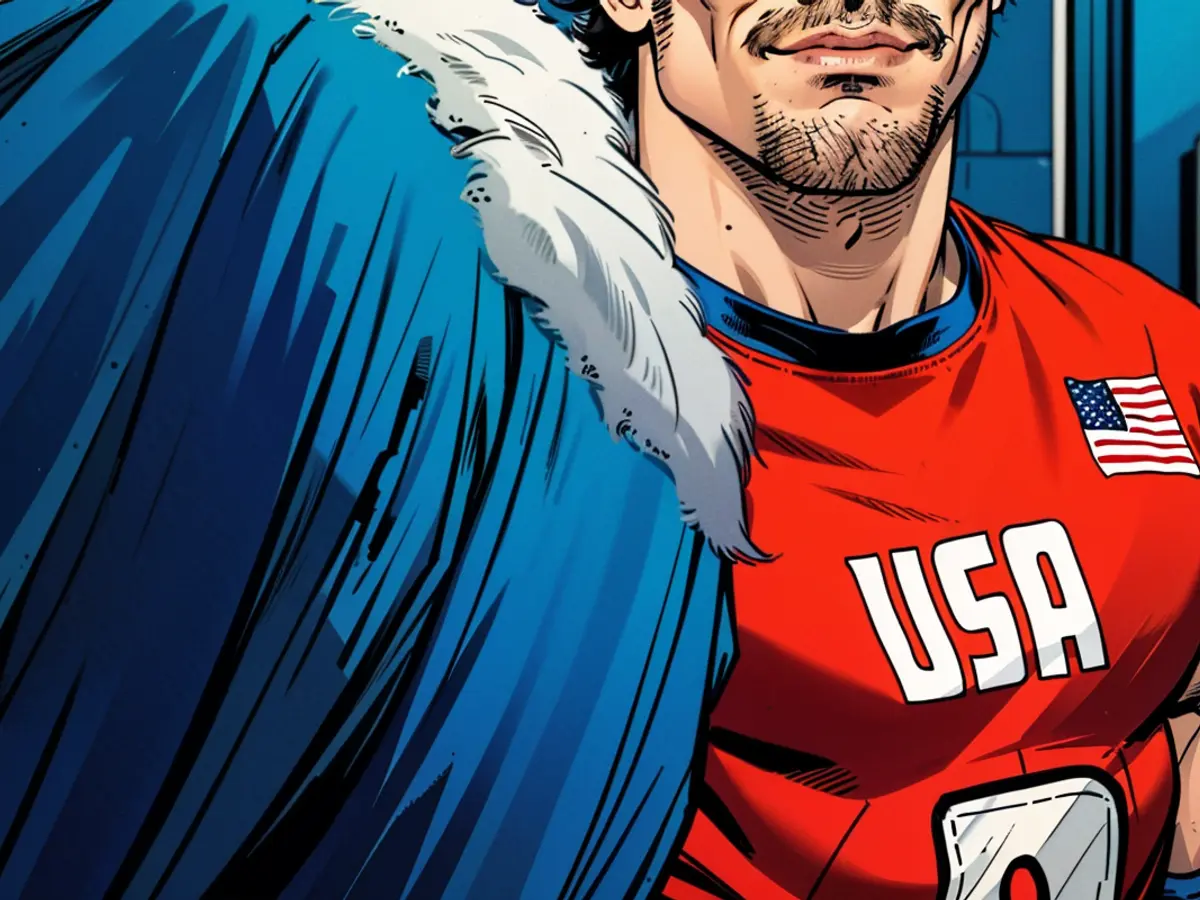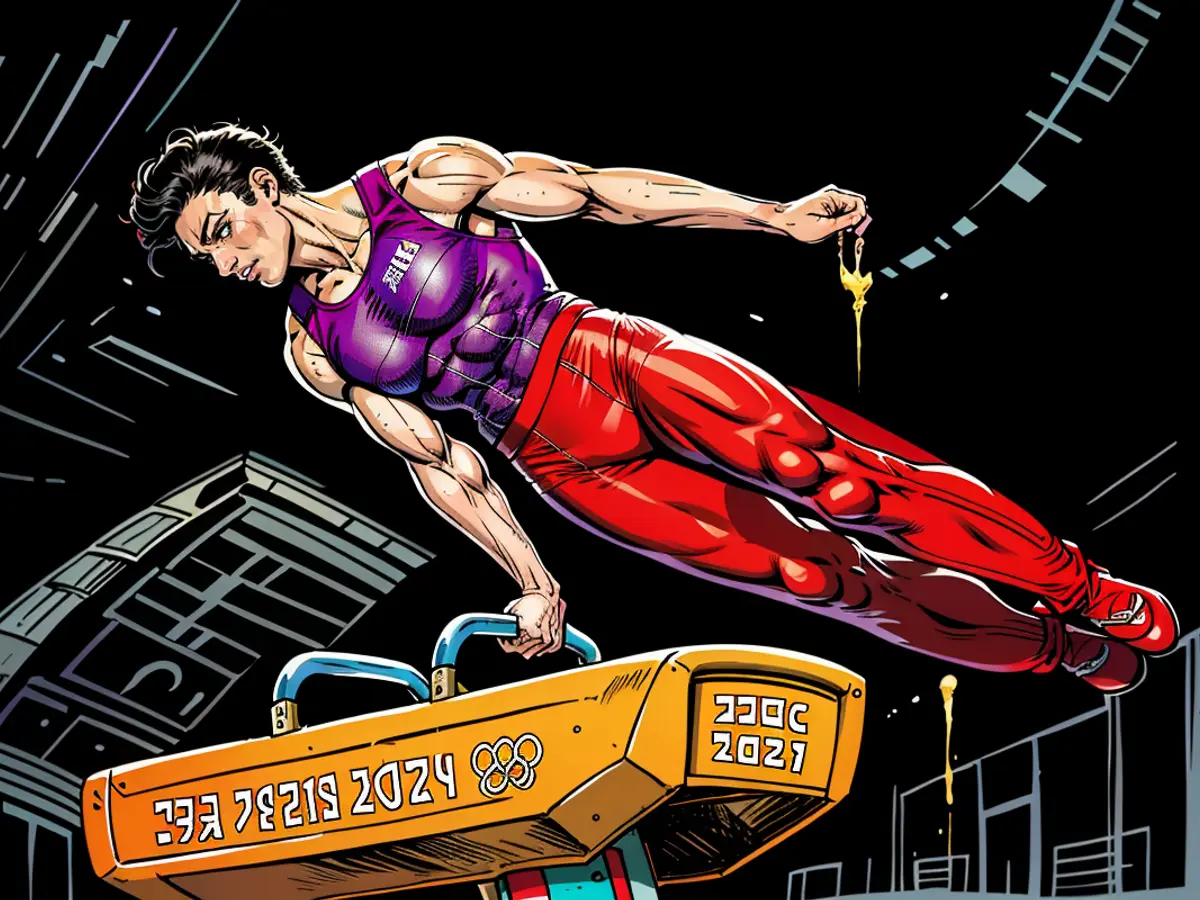These vision-impaired Olympic stars rely on a ‘sixth sense’ when they compete
He stuck the landing, feet squarely on the mat, capturing his second bronzemedal of the Paris Games.
Nedoroscik is not the only Olympic athlete with vision impairment excelling in their sport. Irish swimmer Daniel Wiffen ditched his glasses before clinching the gold in the 800m freestyle on Tuesday. Gymnast Rebeca Andrade of Brazil, who won gold in the vault individual finals during the 2020 Tokyo Games and took silver in Thursday’s individual all-around, has said she cannot see the apparatus that she is hurtling toward at full speed.
Earlier this week Nedoroscik also helped the US men’s team end a 16-year team medal drought and win bronze in Monday’s finals. After his routine he admitted to reporters that although he couldn’t see when he mounted the horse, he didn’t need to.
“When I go up on the pommel horse, it’s all about feeling the equipment. I don’t even see when I’m doing my gymnastics,” he told NBC’s “Today.” “It’s all in the hands. I can feel everything.”
In a podcast released Friday, US national team soccer player Becky Sauerbrunn gave Nedoroscik a shoutout, sharing her experiences playing without corrective lenses and saying she “could tell who a person was by their running gait.”
And Paralympians, such as US men’s goalball co-captain Tyler Merren, have been inspiring and captivating audiences for decades, achieving remarkable feats with partial or complete vision loss. Although Merren has retinitis pigmentosa, a rare eye condition that, over time, has left him with almost completely blindness, he told CNN he “doesn’t feel blind” when he is playing his sport.
“I don’t think about (vision) when I’m on the court. The picture is so clear in my head of the spacing and where the ball is that it’s almost like Technicolor,” he said.
Although every sport and athlete is unique, experts say there is a specific brain science that helps athletes adapt to their visual impairment and remain at the top of their game, even when they may not be able to see it.
Your brain lends a helping hand
Nedoroscik has two conditions: strabismus, or misalignment of the eyes, and coloboma, a loss of tissue in a part of the eye. He has posted on social media about his eyes, demonstrating to viewers how he can rapidly switch which eye is dominant.
Beyond clarity of vision, conditions such as these can affect depth perception, a crucial component to gymnastics and other Olympic sports, according to Dr. Rupa Wong, a pediatric ophthalmologist at the Honolulu Eye Clinic and spokesperson for the American Academy of Ophthalmology.

However, for athletes competing with a wide range of visual impairments, their brains can mold to fill in gaps and adapt to compromised visual input through an ability called neuroplasticity.
“Neuroplasticity is when the brain can change where it’s getting information from, depending on what channel has increased or decreased availability of information,” explained Dr. Gordon Waddington, professor of sport and exercise medicine at the University of Canberra Research Institute for Sport and Exercise and Australian Institute of Sport.
A combination of these “information channels” or systems in the body – namely touch, vision, auditory, proprioceptive and vestibular – enable a person to sense their position in space. Since everyone is unique, we rely on different combinations and varying strengths of these systems to form as complete a picture as possible of our environment and our position within it.
“You grow to rely on other senses like proprioception” when vision is impaired, Wong said. “I have [patients] who have only one eye who are amazing baseball players, and you would think they would need excellent depth perception to be able to play baseball, but they don’t. You can see the compensation and the way the brain is so plastic. ... The brain is constantly changing, especially at a young age.”
What is proprioception?
Proprioception, sometimes deemed the “sixth sense,” is your body’s awareness of its position and movement in space. It is the sense allowing us to feel and locate our body parts, and it’s often confused with balance, according to Dr. Fabrice Sarlegna, who researches movement psychology and neuroscience at the French National Centre for Scientific Research and Aix Marseille University.
“We grew up with the idea of having only five senses, and vision being the dominant sense. ... This is not correct,” he said. “It’s an idea which is about 2,000 years old. Aristotle was very smart, but after 2,000 years, we know that there are more than five senses.
“Even when you cannot see your foot, you know exactly where it is,” he added, explaining how proprioception is maintained by receptors in your body that are constantly communicating with your brain, and vice versa.
We use proprioception to function in our everyday lives with things like taking a sip of water, walking down the street or even simple motions such as closing your eyes to touch your nose with your fingertip.
Olympians and Paralympians use proprioception too. When a gymnast flips in the air and catches the bar, when a swimmer changes directions at the end of a lap or when a goalball player passes the ball, they rely on it to coordinate their movements and execute precise actions without constant visual guidance.

“Proprioception, that sense for awareness, balance and coordination, is massive for athletes,” said Merren.
“That proprioceptive sense when we’re on the court, means I can almost see it. Even without my eyes everything is alive because I know where I am and I know where my teammates are.”
Filling in the gaps
Vision is an important part of an Olympic athlete competing in their sport, but when vision is impaired other senses step up to the plate, according to Sarlegna.
“When you lose one sense or if you have some impairment, the brain is able to compensate to enhance the processing of other sensory modalities,” he said. “For an athlete with a visual impairment, they might have better proprioception, a better vestibular system or better audition. It really depends.”
Strengthening these other senses is also a crucial component of executing a successful routine with less-than-perfect vision. For example, through countless repetitions and practice the brain increases its attention on information coming in through other pathways to create an internal image that allows the athlete to perform skills accurately without relying on perfect vision, according to Waddington.
“There’s no one way for an Olympian to be good at their sport. With eyes open and with perfect 20/20 vision is not the only way we see individuals excelling. [They do so in] so many ways, relying on their other senses to compensate. I think it’s truly amazing,” Wong added.
Lessons from goalball
For Paralympians with near complete vision loss like Merren, tapping into the body’s other senses is especially critical, and comes with a learning curve, particularly in goalball.
Goalball was invented in 1946 to rehabilitate veterans who lost their sight serving in World War II. Combining elements of handball and soccer, the game involves throwing a ball into an opposing team’s guarded net to score points. The ball contains bells, and raised tape on the floor helps players use hearing and touch to locate the ball and their position on the court. Although all players must be legally blind- have less than 10 percent vision- to compete, everyone wears a blindfold to ensure fair competition, according to the International Paralympic Committee.

“As we throw it back and forth, we track the sound of the ball on the floor,” Merren illustrated. “You can also hear the spacing of your players. As we walk around, we generally know where everybody is and use tactile markers to know where we are on the floor.”
Visualization without sight
Athletes can use visualization tools even when they are unable to see. Studies have shown that mental imagery can improve both cognitive and physical performance for athletes of all kinds.
Tapping into the “sixth sense,” communicating between teammates, planning, and sports psychology all help athletes with vision loss paint mental image of their game in their head, according to Merren.
“For athletes, everything is about visualization, and you can have plenty of visualization without having vision. It’s something that we practice. It’s not your eyes, it’s your mind that does the work,” he said. “Our sport is not much different. You take out the visual element, but the athlete is still intact.. Over the years, your brain puts together into an impressive picture.”
Nedoroscik practices this visualization as well. The Olympic bronze medalist, deemed a “sleeper agent” by some, was seen closing his eyes and picturing his routine while waiting for his turn to compete in the team finals. He was also spotted on the sidelines, eyes closed, mentally walking through his pommel horse skills before stepping up to the compete during Olympic qualifications, a routine that helped secure his spot on the 2024 team.
“When you close your eyes, you’re able to picture exactly how you want your body to move,” added Sarlegna, noting there are a lot of “complications” in the brain that turn these visuals into motor action.
A new superpower
Olympic athletes with vision impairment have shown that you don’t need 20/20 vision to get the job done. These athletes serve as role models for children with similar conditions who are getting their start in sports, according to Wong.
Nedoroscik has been compared to Clark Kent, Superman’s alter ego, transforming into a superhero when he takes off his glasses. One of his conditions, strabismus,has also been reported by researchers to be behind the genius of Leonardo da Vinci, allowing the painter to perceive the world differently and facilitating his accurate depiction of three-dimensional objects on flat surfaces.

“I love this concept of it being a superpower,” Wong said. “All of these athletes are so empowering to kids like my patients, who can see [visual impairment] is not limiting them. They can become an Olympian even with coloboma, even with strabismus, even with nearsightedness or needing glasses. The limits can be as simple as what they put on themselves.”
Merren was empowered to play goalball through a US Association of Blind Athletes camp intended to teach kids with vision loss how to play adapted sports. Organizations like these, he said, are crucial in helping kids with vision loss connect with mentors and realize sports are a possibility to them.
“The importance – showing what has been done by others before so you know what you’re capable of – is incalculable,” Merren said. “This changed my perspective about my blindness... being able to see mentors who are blind going to school, traveling the world, starting families, owning businesses and competing in sports.”
According to Merren, the vision impairment doesn’t change the athlete, only the way that the game is performed.
Get CNN Health's weekly newsletter
Sign up here to get The Results Are In with Dr. Sanjay Gupta every Tuesday from the CNN Health team.
“There’s nothing different between a Paralympic athlete and an able-bodied athlete, just that they have a disability. The mentality is the same,” he added “The big thing is not, ‘I’m visually impaired and I’m doing this.’ It’s ‘Look what I am doing regardless of (vision loss).’ ”
As treatment methods for visual impairment progress, such as gene therapy, new tools may become available to help patients such as Wong’s to participate more fully in sports, she said.
“We’re going to see the world open up more to visually impaired children to be able to reach the kind of heights that the current Olympians have,” Wong added.
“Olympians speaking about their vision difficulties and their journeys openly gives so much hope to kids, and their parents too. It is inspiring the next generation. Who knows what future Olympians may be present in this crop that will be inspired to try despite having an eye condition.”
Nedoroscik's visual impairment, including strabismus and coloboma, has not hindered his performance in gymnastics. He explained in an interview that he relies on his sense of touch and the feeling of the equipment to guide his routines, situating himself in space through proprioception.
Proprioception, often deemed as the "sixth sense," plays a significant role in an athlete's awareness of their body's position and movement in space, even when vision is impaired. This sense allows athletes like Merren, who has near-complete vision loss, to compensate for their lack of clear sight by focusing on their other senses, like hearing and touch, to navigate the court during goalball.








